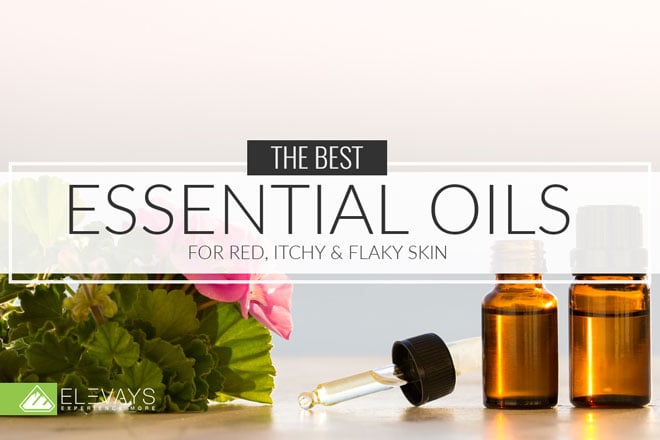There is nothing quite like having issues with your skin. Whether it’s acne, eczema or a mystery rash, skin problems can draw a lot of unpleasant attention. One of the worst is psoriasis because it is often chronic and no one really knows why it happens or how to cure it. Although, essential oils for itchy skin can help – whether it’s red, dry or flaky too.
If you do suffer from psoriasis, keep reading because we’re going to take a good look at the different kinds of psoriasis and most importantly how to get relief for similar symptoms. I’m not claiming a cure here, but there are some natural ways to support skin healing when having a flare-up. And one of the best ways is trying essential oils for red, itchy, and flaky skin. We’ll go through some of my top picks, why they help and share some DIY recipes you can try at home.
What is Psoriasis?
Psoriasis falls into the category of autoimmune conditions, causing an unusual build-up of skin cells that can turn red, itchy and flaky. You see, when skin is functioning normally, a skin cell grows slowly over the course of about a month and then falls away. The difference with psoriasis is that this process happens much faster, perhaps even over days (1).
TRUTH BOMB:
You’re
Already killing it!
If You Were More Consistent With Your Wellness Routine, You’d Be Unstoppable.
Because of this, there is a build up of scaly patches of skin. These are often thick and either white or red in color. The patches can even crack and bleed, causing inflammation and soreness. Not fun and definitely painful! And not all psoriasis is created equal, there are several different types of psoriasis. Below are some of the more common types and the ways they are treated with conventional medicine and those medicines nasty side effects (2).
Plaque Psoriasis
By far the most common type, plaque psoriasis, has the look of red inflamed patches of skin with a white-ish layer over the top. They usually pop up on the elbows, lower back, knees and even around the scalp. Depending on how bad it is, doctors may prescribe oral steroids to bring inflammation down. But these have the nasty side effect of lowering immunity and suppressing adrenal function.
A less aggressive treatment is topical steroid creams, but over time your body can adapt to the cream, rendering it pretty useless. Besides this, there are possible side effects like stretch marks, thinning of the skin and rosacea (3).
Flexural Psoriasis
This one only appears where the skin folds over, like in the groin and under the breasts. Because of the friction, it can be pretty uncomfortable and often appears red and shiny. It is treated the same way as plaque psoriasis with things like topical or oral steroids.
Guttate Psoriasis
After plaque psoriasis, guttate psoriasis is the second most common type and usually shows up in children or young adults after being triggered by something like stress, illness or injury. They aren’t as thick and don’t raise up as plaque psoriasis, instead forming small red bumps.
Pustular Psoriasis
Pustular psoriasis is pretty extreme and can cause symptoms beyond the skin like fever, weakness and a lack of appetite. The scales themselves are small white blisters surrounded by extremely red and inflamed skin. Treatment is the same here too, oral or topical steroids.
So while the types of psoriasis are varied, conventional treatments are the same and leave much to be desired. People struggling with psoriasis are instructed to just live with it or take steroids, which due to their side effects when used over time aren’t really a sustainable option.
But what if I told you there were some natural options that could cut down on healing time without those nasty side effects? And no, I’m not talking about coconut oil, although that can definitely help too! I mean using high-quality essential oil for psoriasis. There are a lot of options you can work with to find the right blend for you and I’ll share some DIY recipes that are great to keep on hand for flare-ups.
Essential Oil for Red, Itchy, & Flaky Skin
Remember that not all essential oils are created equal and you want to make sure you are getting high quality, pure and organic oils. We’ve created a whole blog post to help you with this, but here is a quick summary of my top tips.
- Make sure you find essential oils that have the Latin name, common name, and country of origin. This is because brands that list these are marketing to aromatherapists who look for that kind of information. If licensed aromatherapists use it, it’s probably a good choice.
- Oils should come in dark blue or brown glass bottles that protect them from sun and light exposure. Some oils can go rancid if they come into contact with strong light or heat.
- Less is not more. In the case of essential oils, good ones are often pretty pricey and should be priced accordingly. Oils like orange or lemon will be cheaper than frankincense or sandalwood, simply because they are easier to source. But as a rule, extracting and sourcing quality oils is costly. The good news is that they will last a long time because you really only need a few drops.
So now that you know how to buy essential oils, which ones will really work for skin issues? Here are my top eight essential oils for red, itchy, & flaky skin and how to use them.
Tea Tree Essential Oil
Tea tree or melaleuca is one of my go-to essential oils for just about anything skin related. Tea tree is antimicrobial and anti-inflammatory making it an ideal essential oil for symptoms similar to psoriasis, especially if you’ve been scratching at it. You wouldn’t want to add insult to injury by getting an infection on top of your flaky skin.
Be aware that it’s potent, so when you use tea tree oil for skin irritation make sure it is well diluted in a carrier like fractionated coconut oil. It has its own anti-inflammatory and antimicrobial benefits, so coconut oil for red, itchy skin a great carrier when it comes to making blends for those painful skin lesions.
Frankincense Essential Oil
Another one of my personal favorites is frankincense, known by some as the “king of oils”. Frankincense is a great essential oil for raw skin because it contains boswellic acids which are well known anti-inflammatory compounds.
A 2016 study found that using boswellic acids on certain inflammatory conditions led to a 60-70% improvement in symptoms, without risk of side effects (4). Frankincense also speeds up wound healing by encouraging cell turn over. This is crucial in an essential oil for raw, flaky skin because cells are rapidly building faster than the body can shed them.
As with the other oils, always use just a drop or two in a carrier oil.
Geranium Essential Oil
Another great choice for skin conditions, geranium works to regenerate cells and lower inflammation making it a great essential oil for irritated skin. It has the added effect of reducing the stress response, which is important because unfortunately, stress can exacerbate symptoms of psoriasis.
Geranium is astringent which can help to ease redness and tighten the skin, but if not diluted enough it can also be irritating. Add a drop or two of geranium to a moisture-rich carrier like almond oil and apply it to the affected skin.
Lavender Essential Oil
Lavender is a great essential oil for psoriasis-like symptoms, burns, acne or any other skin issue. Like geranium, it can calm stress and ease inflammation. It’s also a great choice if you have itchy patches and for most people, it can be applied directly to the skin. Just a drop though!
A great way to use lavender is to put a drop or two in the bathtub and allow it to absorb that way. It’s light and soothing floral scent makes it a great choice for using on scalp psoriasis symptoms because you won’t want to wash it off.
Roman Chamomile Essential Oil
Have you ever tried chamomile tea before bed to help you have a good night’s sleep? Well as soothing as it is for your nerves, it does the same for your skin. Anti-inflammatory and calming, roman chamomile is a great essential oil for psoriasis-like symptoms because it will ease redness and moisturize any red and irritated areas.
It is also an analgesic, so if you’re experiencing pain with your red, itchy, and flaky skin, roman chamomile might be the essential oil for you. Simply add a drop of this rich blue oil to a carrier oil and apply it to the skin a few times daily.
Eucalyptus Essential Oil
Remember your mom putting Vicks vapor rub on your chest as a kid? Well, that cooling scent comes from eucalyptus, an essential oil that can alleviate pain, calm inflammation and soothe irritated skin (5).
Eucalyptus oil for skin irritation can work especially well with inflamed and itchy patches. Double down on its healing effects by mixing it with an apricot seed carrier oil. It is known to support cell turnover in the skin and is highly soothing. Since eucalyptus is a strong oil, start with just one drop in apricot seed oil and see how your skin reacts.
Cypress Essential Oil
Antimicrobial and anti-inflammatory compounds make cypress essential oil for psoriasis-like skin another good choice. Like lavender and geranium, cypress is another stress-busting oil that can support skin healing and emotional well being.
Like eucalyptus, cypress has a strong, cooling scent and should be used moderately on the skin in a well-diluted carrier oil. One that most everyone usually has on hand is olive. Olive oil for flaky skin works as a disinfectant and is very moisturizing so if you’ve got flaky scales, this is a good carrier oil to try.
Sandalwood Essential Oil
Sandalwood essential oil is not only anti-inflammatory and skin healing, but it also smells amazing. Sandalwood has been used in India for centuries as a medicine and perfume and science is now even looking at it for the treatment of skin cancers (6). This may be why it is a helpful essential oil for flaky, raw skin, slowing down the growth of unhealthy cells.
Sandalwood is generally safe when a drop or two is applied directly to the skin, and can also be mixed with a carrier oil. Jojoba oil for psoriasis like symptoms is a good choice because it mimics the same oil that’s already present on the skin, which is more like a wax. This means that it is more protective than some of the other carrier oils.
DIY Recipes Using Essential Oil for Red, Itchy & Flaky Skin
Soothing Essential Oil Blend for Irritated Skin
- 1 oz apricot seed oil
- 1 oz jojoba oil
- 5 drops of tea tree essential oil
- 5 drops of sandalwood essential oil
- 5 drops of frankincense essential oil
- 3 drops of eucalyptus essential oil
Blend these together and apply onto the patches of skin as needed, 2-3 times per day. You can switch out any of the above oils in place of these, just try each oil alone and see what feels best for you. You’re making your own essential oil mixture for psoriasis like symptoms, so be creative! Basically, you want a dilution of 15-20 drops of essential oils for 2 ounces of carrier oils.
Healing Vinegar Essential Oils for Scalp Psoriasis Symptoms
- 1 cup of water
- ¼ cup of apple cider vinegar
- 3 drops of geranium essential oil
- 3 drops of lavender essential oil
- 3 drops of roman chamomile essential oil
Blend together and bring the mixture into the shower with you. After shampooing and conditioning your hair, pour the vinegar over it, focusing on any areas of scalp psoriasis-like symptoms. Allow it to sit for at least five minutes and then rinse. The vinegar will help adjust the pH of the scalp and hair, while helping slough away dead skin cells and the essential oils will promote healing.
While there is no known cure, essential oil for irritated skin can help soothe the skin lesions and improve healing time, especially when used right away. As with any new remedy you’re trying, start slow and contact your care provider if you notice any reactions to the oils.
If any of you have experienced psoriasis-like symptoms, I’d love to know what helped you. So if you’ve found some good remedies or have anything of benefit to share, please leave a comment below and tell me about it!
For more killer information on essential oils, check out our Ultimate Essential Oils Guide!
Sources:
- Holland, Kimberly (2018). “Everything You Need to Know About Psoriasis.” Retrieved from: https://www.healthline.com/health/psoriasis
- Brind’Amour, Katie and Rachel Nall (2018). “Types of Psoriasis.” Retrieved from: https://www.healthline.com/health/photos-types-psoriasis
- Brannon, Heather (2018). “Common Side Effects of Steroid Use.” Retrieved from: https://www.verywellhealth.com/steroids-topical-steroid-side-effects-1068831
- Ammon, HP (2016). “Boswellic Acids and Their Role in Chronic Inflammatory Diseases.” Advances in Experimental Medicine and Biology. Retrieved from: https://www.ncbi.nlm.nih.gov/pubmed/27671822
- Babar, Ali. Naser Ali Al-Wabel, Saiba Shams, Aftab Ahamad. Shah Alam Kahn. Firoz Anwar. “Essential Oils Used in Aromatherapy: A Systemic Review.” Asian Pacific Journal of Tropical Biomedicine. Retrieved from: https://www.sciencedirect.com/science/article/pii/S2221169115001033
- Schaefer, Anna (2016). “The Health Potential of Sandalwood Oil.” Retrieved from: https://www.healthline.com/health/what-is-sandalwood









Erica, I found your website while looking for something to help my husband. He has had dry, itchy skin on his lower legs ever since he had two knee replacements done approximately 2 and 2 1/2 years ago. It almost looks like dried blood underneath the skin and is extremely itchy. When he showed his internist and dermatologist, they said there was nothing they could do. I am going to make the mixture for the scalp psoriasis, as he also has this extremely bad. He has a cream for it but it doesn’t help him. I understand you are not a physician but am wondering which essential oil might help him with his lower legs. I’d appreciate your insight on this or a website you could direct me to. My email address is listed below. Thanking you in advance, Peggy A.
Hi Peggy, so sorry to hear about your husband’s struggle. There are awesome essential oils out there that can help with dry, cracked, and itchy skin.
Lavender essential oil is one of the best oils for soothing and repairing skin. Add 1-2 drops to a little bit of coconut oil and massage into areas of dryness. Frankincense is another oil perfect for healing dry skin. Frankincense can get to the cellular level and help repair and rejuvenate. Combine 1-2 drops of frankincense with lavender and coconut oil, and you’ve got yourself a trifecta for soothed, hydrated repaired skin. I hope this helps. Keep me updated!